1984 NISSAN 300ZX air condition
[x] Cancel search: air conditionPage 1 of 38
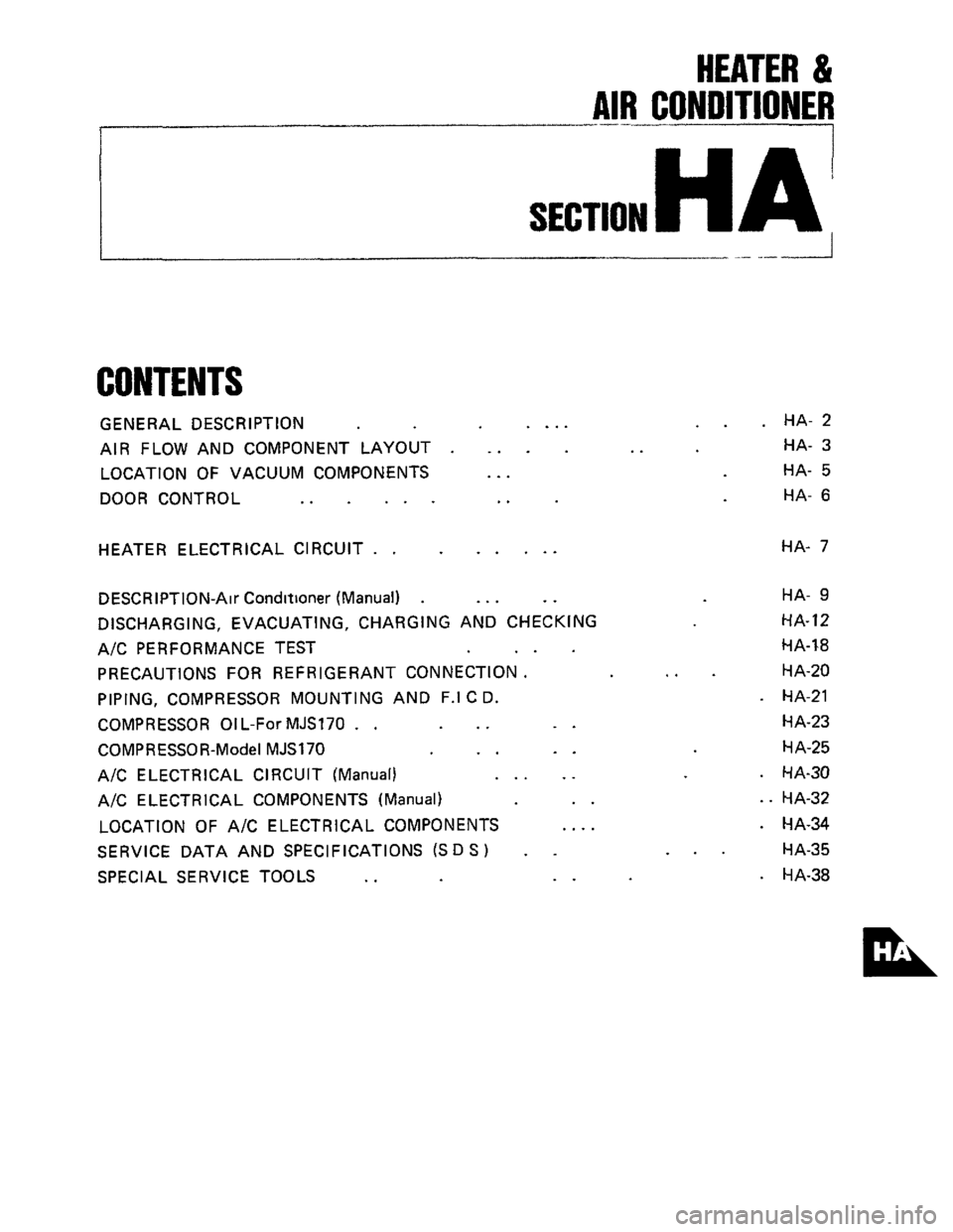
HEATER &
AIR CONDITIONER
I v __I_--
SECTION HA^ I
CONTENTS
GENERAL DESCR I PTlON . ... .. . HA- 2
AIR FLOW AND COMPONENT LAYOUT
. .. . .. HA- 3
DOOR CONTROL .. 1.. .. HA- 6
LOCATION OF VACUUM COMPONENTS ... HA- 5
HEATER ELECTRICAL CIRCUIT. . . . . .. HA- 7
DESCRIPTION-Air Conditioner (Manual) . ... ..
A/C PERFORMANCE TEST ..
DISCHARGING, EVACUATING, CHARGING AND CHECKING
PRECAUTIONS FOR REFRIGERANT CONNECTION .
PIPING, COMPRESSOR MOUNTING AND F.1 C D.
COMPRESSOR OIL-ForMJS170
. . .. ..
COMPRESSOR-Model MJS170 .. ..
A/C ELECTRICAL CIRCUIT (Manual) . .. ..
A/C ELECTRICAL COMPONENTS (Manual) ..
LOCATION OF A/C ELECTRICAL COMPONENTS ....
SERVICE DATA AND SPECIFICATIONS (S D S ) . .
SPECIAL SERVICE TOOLS .. ..
HA- 9
HA-12
HA-18
HA-20
. HA-21
HA-23
HA-25
. HA-30
.. HA-32
. HA-34
.. HA-35
. HA-38
Page 2 of 38
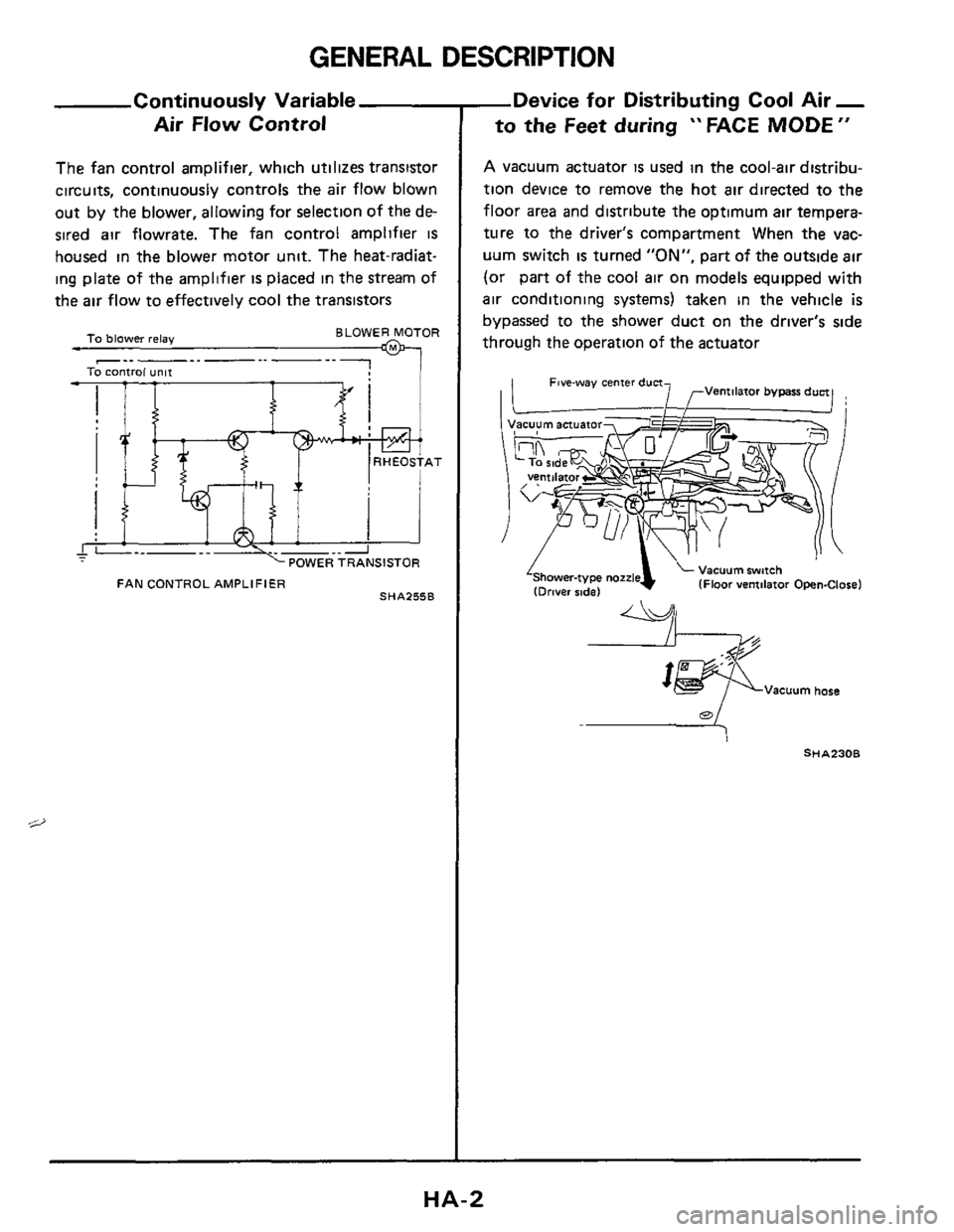
GENERAL DESCRIPTION
Continuously Variable Air Flow Control
The fan control amplifier, which utilizes transistor
circuits, continuously controls the air flow blown
out
by the blower, allowing for selection of the de-
sired air flowrate. The fan control amplifier
IS
housed in the blower motor unit. The heat-radiat-
ing plate of the amplifier
is placed in the stream of
the air flow to effectively cool the transistors
BLOWER MOTOR To blower relay M
AT AT
I - I __4;-..2 POWER TRANSISTOR
FAN CONTROL AMPLIFIER SHA255B
-Device for Distributing Cool Air -
to the Feet during " FACE MODE "
A vacuum actuator is used in the cool-air distribu-
tion device to remove the hot
air directed to the
floor area and distribute the optimum air tempera-
ture to the driver's compartment When the vac-
uum switch
is turned "ON", part of the outside air
(or part of the cool air on models equipped with
air conditioning systems) taken in the vehicle is
bypassed to the shower duct on the driver's side
through the operation of the actuator
4 Vacuum swfch IFloor ventilator Open-Close) 'Shower-ty pe nozzle (Driver sidel
Vacuum hose
a
HA-2
Page 6 of 38
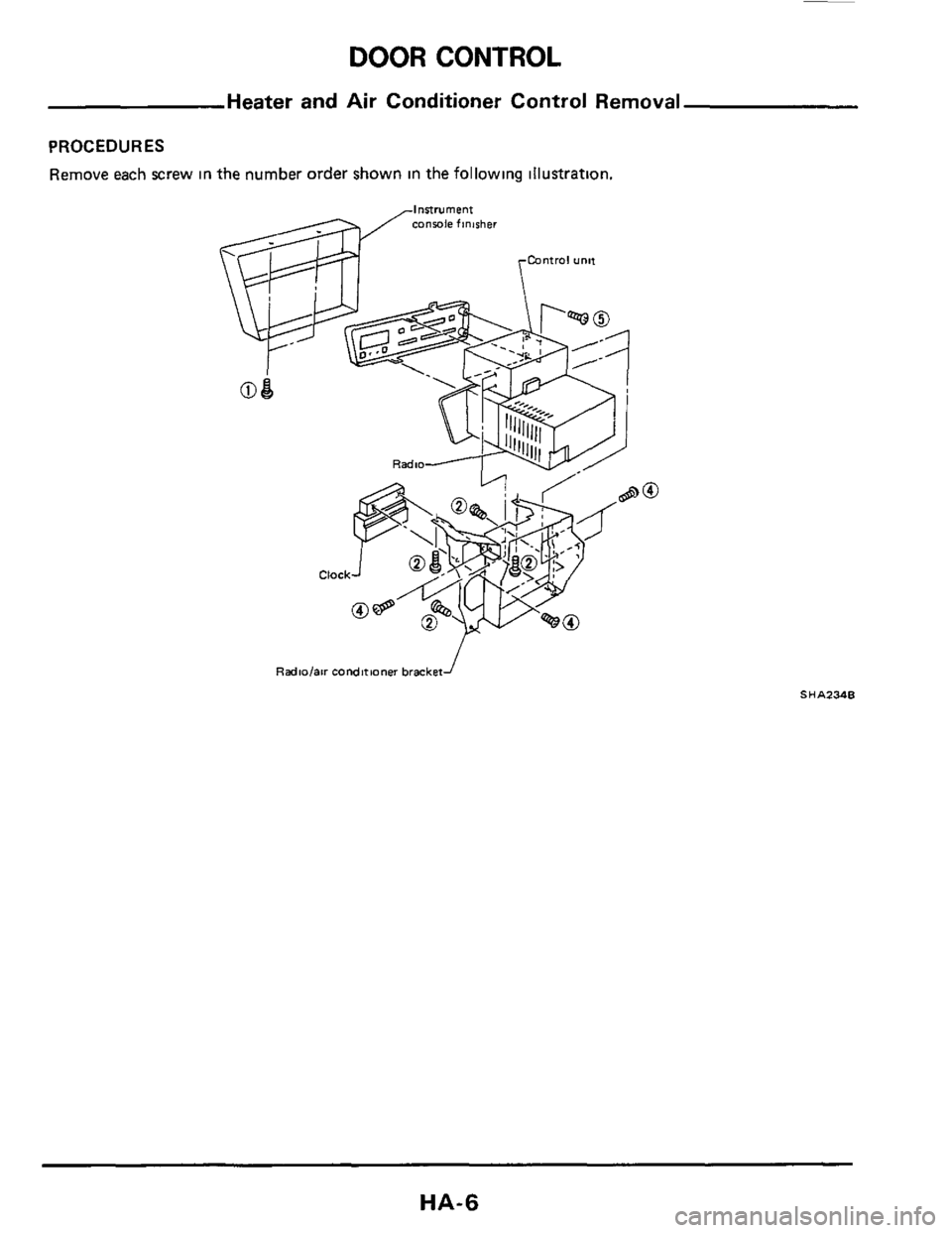
DOOR CONTROL
Heater and Air Conditioner Control Removal
PROCEDURES
Remove each screw in the number order shown in the following illustration.
Radiolaw condnmner bracket f
SHA234B
HA-6
Page 9 of 38
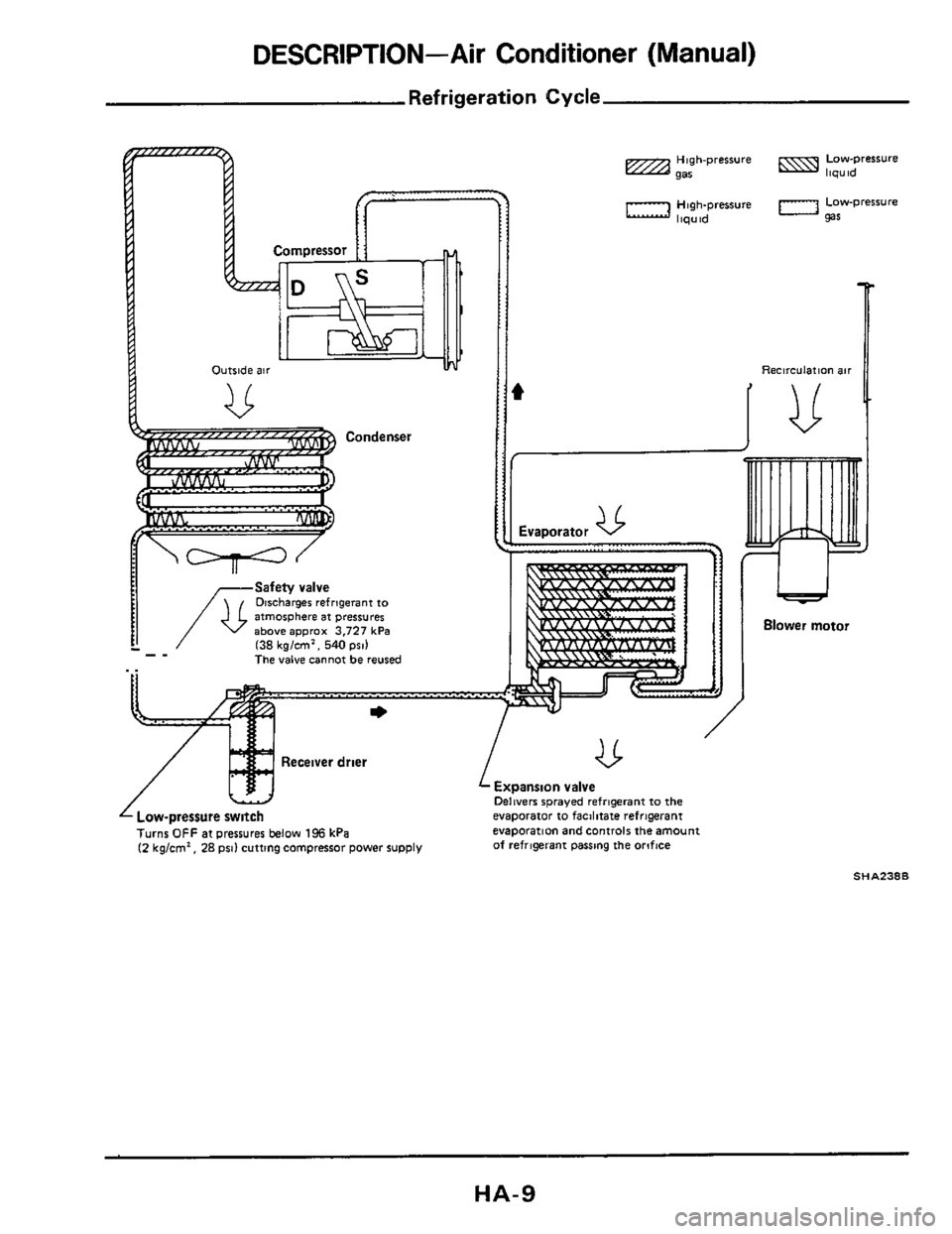
DESCRIPTION-Air Conditioner (Manual)
Refrigeration Cycle
Condenser
Safety valve Discharger refrigerant to
atmosphere at pressures above approx 3,727 kPa (38 kg/cm'. 540 psi) The valve cannot be reused -_ ..
Receiver drier
Delivers sprayed refrlgerant to the
evaporator to facilitate refrigerant
evaporation and controls the amount
of refrigerant passing the orifice
Turns OFF at pressures below 196 kPa (2 kglcm', 28 psi1 cutting compressor power supply
v
I
44
Blower motor
SHA238B
Page 10 of 38
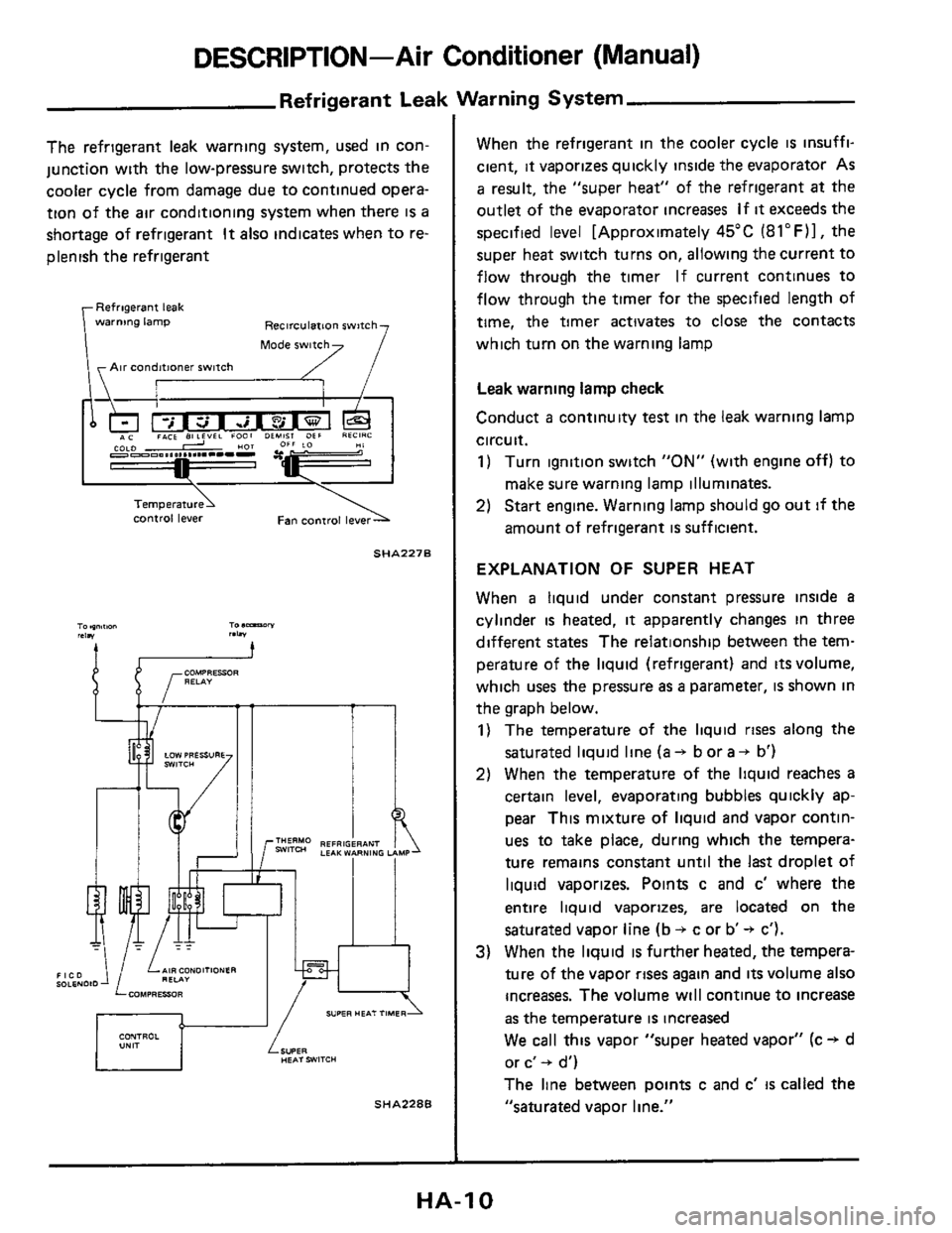
DESCRIPTION-Air Conditioner (Manual)
Refrigerant Leak Warning System
The refrigerant leak warning system, used in con-
junction with the low-pressure switch, protects the
cooler cycle from damage due to continued opera-
tion of the
air conditioning system when there is a
shortage of refrigerant
It also indicates when to re-
plenish the refrigerant
Refrigerant leak
warnmg lamp Recirculation switch
Air conditioner switch
control lever
SHA227B
I ll I
SHA2286
When the refrigerant in the cooler cycle is insuffi-
cient,
it vaporizes quickly inside the evaporator As
a result, the "super heat" of the refrigerant at the
outlet of the evaporator increases
If it exceeds the
specified level [Approximately 45°C
(8l0F)1, the
super heat switch turns on, allowing the current to
flow through the timer If current continues to
flow through the timer for the specified length of
time, the timer activates to close the contacts
which turn on the warning lamp
Leak warning lamp check
Conduct a continuity test in the leak warning lamp
circuit.
1) Turn ignition switch "ON" (with engine off) to
make sure warning lamp illuminates.
2) Start engine. Warning lamp should go out if the
amount of refrigerant
is sufficient.
EXPLANATION OF SUPER HEAT
When a liquid under constant pressure inside a
cylinder is heated, it apparently changes in three
different
states The relationship between the tem-
perature of the liquid (refrigerant) and
its volume,
which
uses the pressure as a parameter, is shown in
the graph below.
1) The temperature of the liquid rises along the
saturated liquid line (a -+ b or a + b')
2) When the temperature of the liquid reaches a
certain level, evaporating bubbles quickly ap-
pear This mixture of liquid and vapor contin-
ues to take place, during which the tempera-
ture remains constant until the
last droplet of
liquid vaporizes. Points c and c' where the
entire liquid vaporizes, are located on the
saturated vapor line (b
+ c or b -+ c').
3) When the liquid is further heated, the tempera-
ture of the vapor
rises again and its volume also
increases.
The volume will continue to increase
as the temperature is increased
We call this vapor "super heated vapor" (c + d
or c'
+ d')
The line between points c and c'
is called the
"saturated vapor line."
HA-I 0
Page 11 of 38
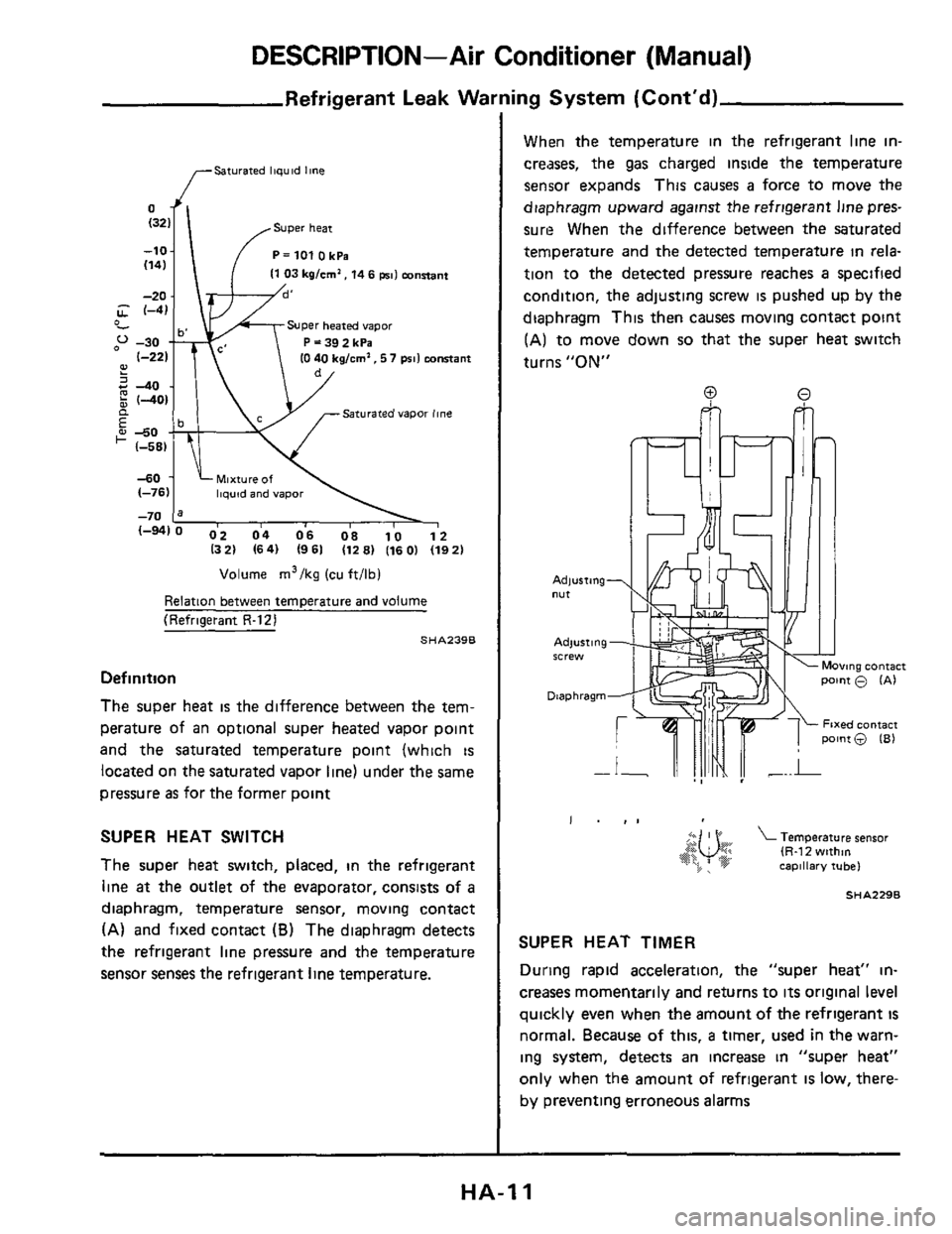
DESCRIPTION-Air Conditioner (Manual)
Refrigerant Leak Wai
,---Saturated liquid line
Super heat
-10 P=1010kPa
I1 03 kg/cm2, 14 6 si1 mnsant (141
U 4- Super heated vapor
P = 39 2 kPa 10 40 kglcm', 5 7 pal mmtant (-221
2 -40
P Saturated vapor line
5 40 + (-581
40 1, k;xture; 1 , (-761 liquid and vapor
-70
(-9410 02 04 06 08 10 12 1321 (641 (9 61 (12 81 (16 01 (1921
Volume m3/kg (cu ftilb)
Relation between temperature and volume
(Refrigerant R-121
SHA2398
Definition
The super heat is the difference between the tem-
perature of an optional super heated vapor point
and the saturated temperature point (which
is
located on the saturated vapor line) under the same
pressure
as for the former point
SUPER HEAT SWITCH
The super heat switch, placed, in the refrigerant
line
at the outlet of the evaporator, consists of a
diaphragm. temperature sensor, moving contact
(A) and fixed contact (B) The diaphragm detects
the refrigerant line pressure and the temperature
sensor senses the refrigerant line temperature.
ing System (Cont'd)
When the temperature in the refrigerant line in-
creases, the
gas charged inside the temperature
sensor expands This causes
a force to move the
diaphragm upward against
the refrigerant line pres-
sure When
the difference between the saturated
temperature and the detected temperature
in rela-
tion to the detected pressure reaches
a specified
condition, the adjusting screw
is pushed up by the
diaphragm This then causes moving contact point
(A) to move down so that the super heat switch
turns
"ON"
0
vmg COntaCt
I . ,I
$(& Temperature sensor & (R-12 within b~ capillary rubel
SHA2298
SUPER HEAT TIMER
During rapid acceleration, the "super heat" in-
creases momentarily and returns to
its original level
quickly even when the amount of the refrigerant
is
normal. Because of this, a timer, used in the warn-
ing system, detects an increase
in "super heat"
only when the amount of refrigerant
is low, there-
by preventing erroneous alarms
HA-I 1
Page 16 of 38
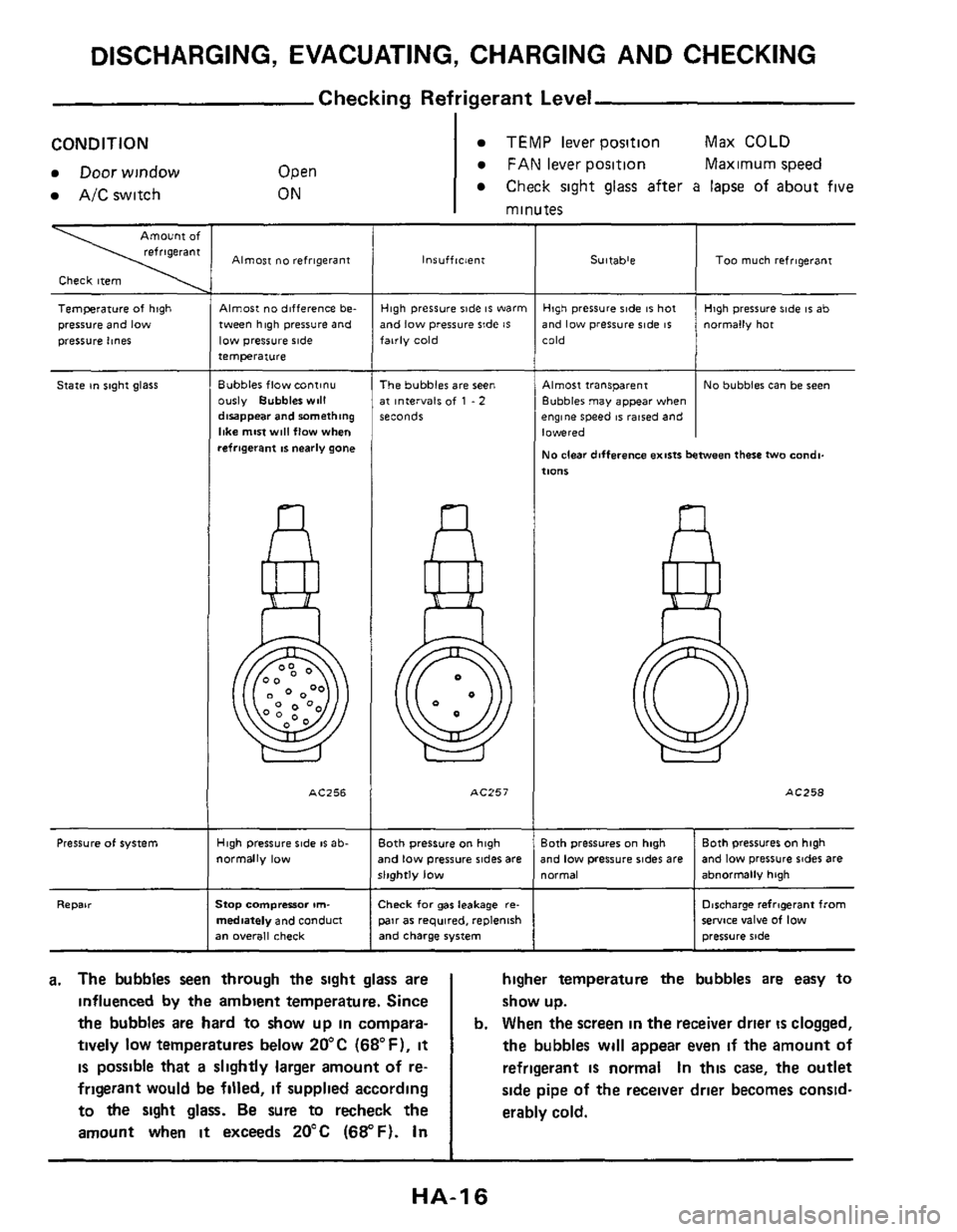
DISCHARGING, EVACUATING, CHARGING AND CHECKING
Checking Refrigerant Level
I
Suitable
CONDITION
Door window
AIC switch
TOO much refrigerant
Open
ON
TEMP lever position Max COLD
FAN lever position Maximum speed
Check sight glass after a lapse of about five
minutes
Check item
Terneralure of high
pressure and
low
pressure lines
Staie !n slght glass
Pressure of system
Repair
Almost no refrigerant
Almost no difference be-
tween high pressure and
low pressure side temperature
Bubbles flow continu
ously Bubbler will disappear and something
like mest will flow when
refrigerant
IS nearly gone
AC256
High Pressure side os ab-
normally low
Stop compressor m.
mediately and conduct an Overall check
iigh pressure side IS warm
Ind low pressure side is
awly cold
-he bubbler are seen
it inieivals of 1 - 2
econds
ACZ57
loth pressure on high
nd low pressure sides are
lighfly low
:heck for gas leakage re-
air as required. replenish Nnd charge system
a. The bubbles seen through the sight glass are
influenced by the ambient temperature. Since
the
bubbles are hard to show up in compara-
tively
low temperatures below 20°C (68°F). it
is possible that a slightly larger amount of re-
frigerant would be filled,
if supplied according
to the sight glass.
Be sure to recheck the
amount when
it exceeds 20°C (68°F). In
iigh pressure ride is hot
ind
low pressure ride 8s
High pressure Side IS ab
normally hot
4Imost transparent
lubblei may appear when ,ngine speed 8s raised and
owered
do dear difference exists between these two condi-
No bubbler can be seen
10"s
AC258
:oth pressures on high
nd
low pressure rides are ormal abnormally hgh
Both pressures on high
and
low pressure rider are
Dmharge refragerant from sewice valve of low
pressure ride
higher temperature the bubbles are easy to
show up.
b. When the screen in the receiver drier is clogged,
the bubbles will appear
even if the amount of
refrigerant
IS normal In this case, the outlet
side pipe of the receiver drier becomes consid-
erably cold.
1
HA-I 6
Page 18 of 38
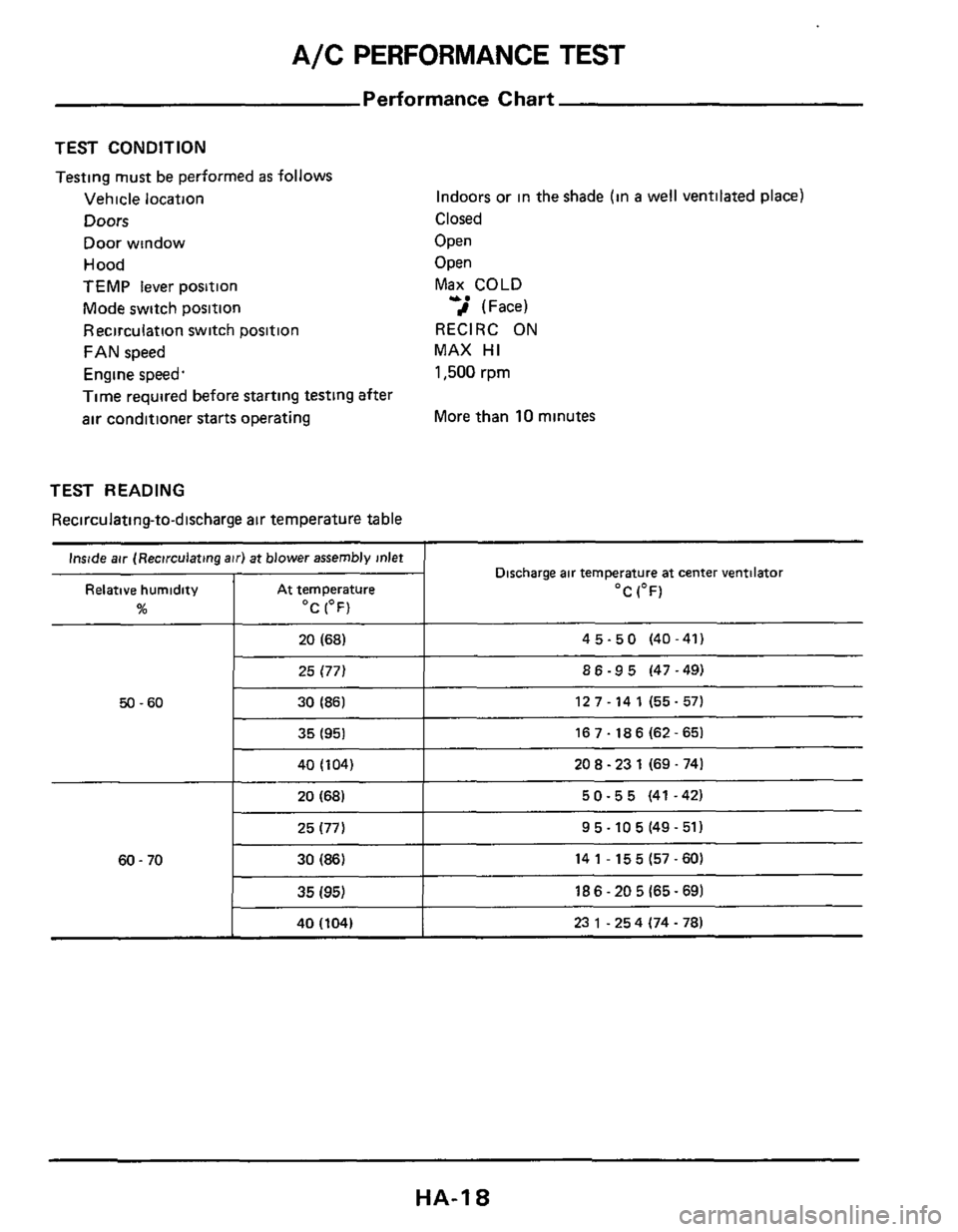
A/C PERFORMANCE TEST
Performance Chart
Inside air (Recirculating air) at blower assembly inlet
Relative humidity At temperature
% OC (OF)
20 (68)
TEST CONDITION
Testing must be performed as follows
Vehicle location
Doors
Door window
Hood
TEMP lever position
Mode switch position
Recirculation switch position
FAN speed
Engine speed'
Time required before starting
testing after
air conditioner starts operating
Discharge air temperature at center ventilator
'C (OF)
45-50 (40-41)
TEST READING
Recirculating-to-discharge air temperature table
50-60
Indoors or in the shade (in a well ventilated place)
Closed
Open
Open Max
COLD
# (Face)
RECIRC ON
MAX HI
1,500 rpm
More than 10 minutes
-.
86-95 (47-49)
12 7
- 14 1 (55 - 57)
16 7.186
(62 -65)
25 (77)
30 (86)
35 (951
60 - 70
50-55 (41-42)
9 5
- 10 5 (49 - 51)
14
1 - 15 5 (57- 60)
18 6 - 20 5 (65 - 69)
20 (68)
25 (77)
30
(86)
35 (95)
208-231 (69-74)
40 (104) 231 -254174-78)
HA-I 8